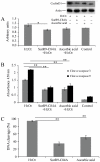Survivin mutant protects differentiated dopaminergic SK-N-SH cells against oxidative stress
- PMID: 21249229
- PMCID: PMC3018429
- DOI: 10.1371/journal.pone.0015865
Survivin mutant protects differentiated dopaminergic SK-N-SH cells against oxidative stress
Erratum in
- PLoS One. 2011;6(2). doi: 10.1371/annotation/c6435c2d-0692-476f-8795-d8e49421cd3c
-
Correction: Survivin Mutant Protects Differentiated Dopaminergic SK-N-SH Cells Against Oxidative Stress.PLoS One. 2018 Mar 15;13(3):e0194587. doi: 10.1371/journal.pone.0194587. eCollection 2018. PLoS One. 2018. PMID: 29543866 Free PMC article.
Abstract
Oxidative stress is due to an imbalance of antioxidant/pro-oxidant homeostasis and is associated with the progression of several neurological diseases, including Parkinson's and Alzheimer's disease and amyotrophic lateral sclerosis. Furthermore, oxidative stress is responsible for the neuronal loss and dysfunction associated with disease pathogenesis. Survivin is a member of the inhibitors of the apoptosis (IAP) family of proteins, but its neuroprotective effects have not been studied. Here, we demonstrate that SurR9-C84A, a survivin mutant, has neuroprotective effects against H₂O₂-induced neurotoxicity. Our results show that H₂O₂ toxicity is associated with an increase in cell death, mitochondrial membrane depolarisation, and the expression of cyclin D1 and caspases 9 and 3. In addition, pre-treatment with SurR9-C84A reduces cell death by decreasing both the level of mitochondrial depolarisation and the expression of cyclin D1 and caspases 9 and 3. We further show that SurR9-C84A increases the antioxidant activity of GSH-peroxidase and catalase, and effectively counteracts oxidant activity following exposure to H₂O₂. These results suggest for the first time that SurR9-C84A is a promising treatment to protect neuronal cells against H₂O₂-induced neurotoxicity.
Conflict of interest statement
Figures




References
-
- Barone P. Neurotransmission in Parkinson's disease: beyond dopamine. European Journal of Neurology. 2010;17:364–376. - PubMed
-
- Jenner P. Oxidative stress in Parkinson's disease. Annals of Neurology. 2003;53:S26–S36. - PubMed
-
- Kanwar JR, Kanwar RK, Burrow H, Baratchi S. Recent Advances on the Roles of NO in Cancer and Chronic Inflammatory Disorders. Current Medicinal Chemistry. 2009;16:2373–2394. - PubMed
-
- Lotharius J, Brundin P. Pathogenesis of Parkinson's disease: Dopamine, vesicles and alpha-synuclein. Nature Reviews Neuroscience. 2002;3:932–942. - PubMed
-
- Graham DG. Oxidative pathways for catecholamines in the genesis of neuromelanin and cytotoxic quinones. Molecular Pharmacology. 1978;14:633–643. - PubMed
Publication types
MeSH terms
Substances
LinkOut - more resources
Full Text Sources
Research Materials

